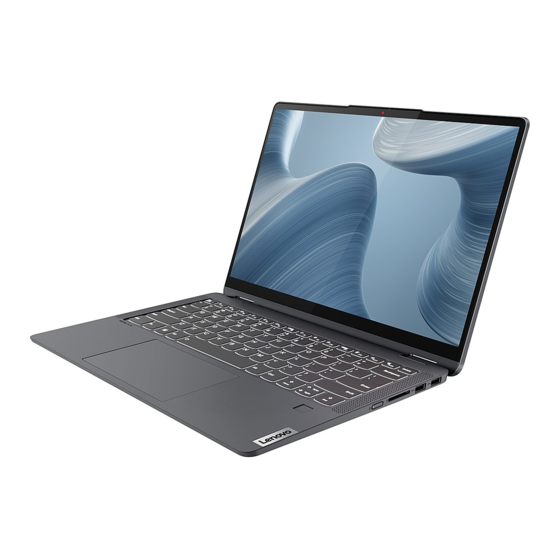
Summarization of Contents
Chapter 1. Meet Your Computer
Front Components Overview
Identifies and describes front-facing components like microphones, camera, and screen.
Base Components Overview
Details components on the computer's base, including ventilation, speakers, keypad, and touchpad.
Left Side Ports and Connectors
Describes ports and connectors on the left side, such as power, HDMI, and USB-C.
Right Side Ports and Connectors
Lists and explains components on the right side, including power button, SD card slot, and USB ports.
Bottom Ventilation Slots
Details ventilation slots on the bottom for heat dissipation, emphasizing not to block them.
Detailed Features and Specifications
Provides specifications for dimensions, power adapter, battery, memory, storage, screen, and keyboard.
USB Transfer Rate Information
Explains factors affecting USB transfer speeds and lists data rates for USB 3.2 Gen 1 and Gen 2.
Operating and Storage Environment
Outlines operating/storage conditions: altitude, temperature ranges, and relative humidity.
Safety: Avoid Contact with Hot Sections
Advises users to avoid prolonged direct contact with hot parts of the computer during operation.
Chapter 2. Get Started with Your Computer
Basic Windows Operations
Guides on basic Windows settings: Control Panel, Wi-Fi, Airplane mode, Night light.
Windows Help and Troubleshooting Resources
Provides resources for obtaining online Windows help and troubleshooting assistance.
Lenovo Software: Vantage & PC Manager
Introduces Lenovo software for system status, settings management, and updates.
Novo Button Menu Access
Explains how to access the Novo Button menu for BIOS, boot options, and startup recovery.
Interacting with Your Computer
Details how to interact with the computer using keyboard hotkeys and function keys.
Keyboard Hotkeys Guide
Lists keyboard shortcuts for common functions like volume, brightness, and media control.
Hotkey Mode Configuration
Explains how to switch between using hotkeys directly or with the Fn key via BIOS settings.
FnLock Switch Functionality
Describes the FnLock switch that reverses default hotkey behavior, toggled with Fn+ESC.
Numeric Keypad Usage
Details the numeric keypad function and how to enable/disable it with NumLock.
Windows Touch Gestures and Operations
Illustrates and explains common touch gestures on the screen and touchpad.
Using the Digital Pen
Guides on using the digital pen for writing/drawing, including button functions and settings.
Lenovo Digital Pen Details
Provides information on the Lenovo Digital Pen, its care, and purchasing options.
Chapter 3. Explore Your Computer
Power Management Overview
Covers managing power, checking battery status, charging, and power button behavior.
Checking Battery Status
Explains how to check battery levels, charging times, and optimal charging conditions.
Setting Power Button Behavior
Details how to configure the power button's action, such as sleep mode or shutdown.
Understanding Power Plans
Describes power plans as energy-saving settings and how to customize them.
Customizing Power Plans
Guides on how to change or customize existing power plans within Windows settings.
UEFI/BIOS Setup Utility Guide
Introduces the UEFI/BIOS setup utility and its role in initializing hardware and loading the OS.
Accessing UEFI/BIOS Settings
Provides step-by-step instructions on how to enter the UEFI/BIOS setup utility.
Configuring Boot Devices
Explains how to change boot order or select a boot device from the boot menu or UEFI/BIOS.
Modifying Hotkey Mode
Details how to modify hotkey behavior (Fn key priority) within the UEFI/BIOS settings.
Always-On USB Configuration
Explains how to enable/disable the always-on USB connector functionality in UEFI/BIOS.
UEFI/BIOS Password Security
Introduces password types (admin, user, hard disk) and their usage in UEFI/BIOS security.
Setting Administrator Password
Guides on setting an administrator password to prevent unauthorized access to UEFI/BIOS setup.
Managing Administrator Password
Provides steps to change or remove the administrator password for UEFI/BIOS.
Setting User Password
Explains how to set a user password for limited access to UEFI/BIOS settings.
Enabling Power-On Password
Describes how to enable a power-on password for enhanced system security at startup.
Setting Hard Disk Password
Guides on setting a hard disk password to protect data access and prevent unauthorized use.
Managing Hard Disk Password
Details procedures for changing or removing hard disk master and user passwords.
Chapter 4. Help and Support
Frequently Asked Questions (FAQ)
Addresses common user queries regarding storage, system freezes, and liquid spills.
Self-Help and Troubleshooting Resources
Lists resources for troubleshooting, FAQs, accessibility, and system recovery options.
Understanding CRUs
Defines Customer Replaceable Units (CRUs) and their types: self-service and optional-service.
Product-Specific CRUs
Lists specific CRUs for the product model, categorizing them as self-service or optional-service.
Contacting Lenovo Support
Provides guidance on contacting Lenovo Customer Support, including information needed and services offered/not covered.
Preparing for Support Contact
Advises users on product information and problem details to record before contacting support.
Lenovo Customer Support Center
Details how to contact the Lenovo Customer Support Center for warranty period assistance.
Purchasing Additional Services
Explains options for purchasing additional services from Lenovo during and after the warranty period.
Appendix A. Notices and Trademarks
Important Legal Notices
Contains legal information, disclaimers, warranty statements, and intellectual property rights.
Trademark Acknowledgments
Lists trademarks for Lenovo and other companies related to product components and technologies.










Need help?
Do you have a question about the IdeaPad Flex 5 16IAU7 and is the answer not in the manual?
Questions and answers